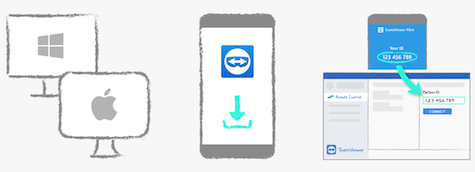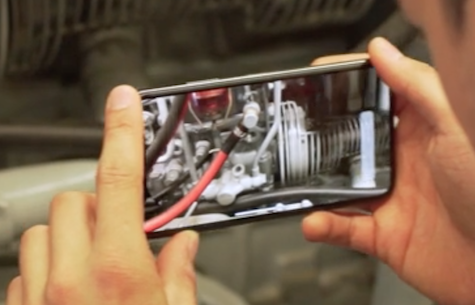TeamViewer 14 and TeamViewer Pilot
Cross-platform screen sharing and new iOS app remote camera support
An interview with Andreas Haizmann, senior product manager TeamViewer Pilot
WHAT IS ARKIT AND WHY IS IT IMPORTANT?
ARKit is an Apple framework embedded in iOS that allows developers to create augmented reality apps. The most recent iPhones/iPads have this bundled in it. Essentially this is what allows applications to place virtual objects in your physical world.
WHAT’S SO NEW AND GREAT ABOUT TEAMVIEWER 14?
TeamViewer is a remote connectivity tool that is used by tens of millions of people every day, and the new TeamViewer 14 has a lot of great new features and functions around ease-of-use and better performance – like saving custom scripts in a drop-down menu, dark mode, advanced device grouping and drastically improved performance in low bandwidth situations. Perhaps one of the biggest additions to TeamViewer 14 is a new augmented reality tool called Pilot.  This is integrated within TeamViewer 14, but can also be installed and run totally separate.
WHAT IS SPECIAL ABOUT PILOT?
TeamViewer Pilot is very interesting because it really builds off of our strength in remote access and support. Typically, people use TeamViewer to support computers to computers, or computers to mobile devices, mobile to computers, and even mobile to servers or other unattended devices like IoT devices. With Pilot, experts on a Mac or PC can provide remote support to people for any type of real world issue. An expert can see exactly what you see through your iPhone or iPad and direct you to fix a problem.
WHICH APPLE DEVICES WORK WITH YOUR NEW APPLICATIONS?
For Pilot specifically, it’s iPhones from 6s and newer and iPads 5th generation or later, but TeamViewer 14 can support nearly any Apple, or other, device out there on some level.Â
WHAT TECH AND NON TECH SITUATIONS ARE MOST SUITED TO PILOT?
We anticipate TeamViewer Pilot being used in a number of ways, from grandkids helping grandparents with paper jams, to cable repairmen helping customers set up Internet connections from hundreds of miles away. Some areas that come up often are field service — arming your on-site technicians with knowledge to fix issues in the field by remotely viewing issues through their phone’s camera and making annotations on the screen to show them how to fix it. Maintenance & Repair also pops up a lot — reducing downtime and helping your mechanics repair devices on the factory floor when breakdowns occur. Training also come up a lot – training, onboarding and educating your employees or customers as if you were in the same room. We are really interested to see how Pilot will be used in non-commercial situations. It’s a brand new tool and we want to get it in as many hands as possible.
WHY ARE THERE ONLY ARROWS AND NOT OTHER SYMBOLS? HOW ABOUT DRAWING AND OTHER MARKERS?
We started with numbered arrows that can direct people into a series of requests. Both the expert and end users can make these annotations. We’ll add free-hand drawing as a further annotation tool soon.  As we get more data on how people prefer to use Pilot, we’ll continue to adjust our development agenda.
WHY ARE YOUR ARROWS ONLY TURQUOISE AND BLUE?
That’s a good question! These are just two colors that match our design guide. What was important to us, was that we have two separate colors, so that experts and end users can distinguish between their arrows and those provided by the expert that is supporting them.
WHAT KEEPS THE ARROWS FROM JUMPING AROUND AS USERS MOVE THEIR PHONES AND PADS?
Basically, this goes back to ARkit – this defines planes or surfaces and key reference points.  It continually scans to detect feature points on objects and flat surfaces. When you create an arrow in Pilot, that arrow attaches to one of those reference points, so that no matter where you reposition the camera, it stays attached to that point and only that point.  You can turn around or move toward that point from a totally different direction and the arrow will stay in the same spot because its fixed to a three-dimensional point in the real world.
HOW WELL WILL PILOT WORK ON CELLULAR AND SLOW WiFi CONNECTIONS?
TeamViewer 14 and TeamViewer Pilot work well in all kinds of network situations already. There are a lot of technical measures in place to detect the current bandwidth and adopt session parameters accordingly. However, with one of the next releases we are going to improve on 3G connections even further.
DOES ALL THIS PERFORM EQUALLY WELL ON ALL PLATFORMS, MOBILE AND DESKTOP/LAPTOP?
Yes – it really does. The end user will always be on a mobile device with Pilot, and for now, the expert will be on a desktop or laptop. Connections from mobile to other mobile devices are already on our roadmap.
DOES REMOTE CAMERA SHARING REALLY WORK AS ADVERTISED?
It really does. That’s why we chose the mobile device as the primary lens to share what you are doing with experts. It’s also ubiquitous – everyone has an iPhone, iPad or Android device with them at all times of the day. Mobile devices are something everyone has and are comfortable using.
IS ALL THIS FREE? HOW DO YOU MAKE ANY MONEY?
Pilot is totally free for non-commercial, private use. We have a variety of competitive pricing options for commercial-use and special pricing for existing TeamViewer customers. So basically, we charge for most TeamViewer software, only if you are using it for a business purpose. You can add Pilot onto a TeamViewer subscription, or get it as a stand-alone app on a per-seat, subscription basis.
CAN SESSIONS BE RECORDED, INCLUDING VOICE COMMENTARY AND INSTRUCTIONS?
Right now, the video isn’t recorded, but we have plans to add that capability in a future version. We are going to support the same functionalities as provided when remotely controlling another device. This includes video recording, as well as session protocolling.
CAN PILOT SESSIONS BE HACKED BY UNSCRUPULOUS CREEPS?
Pilot is as secure as all other TeamViewer sessions. All connections are end-to-end encrypted with military grade encryption algorithms, so bad guys have no chance of listening in or hijacking the session.







Leave a Reply
You must be logged in to post a comment.